Conjugated pi Study guides, Class notes & Summaries
Looking for the best study guides, study notes and summaries about Conjugated pi? On this page you'll find 52 study documents about Conjugated pi.
Page 4 out of 52 results
Sort by
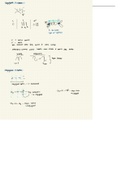
-
Organic Chemistry: Conjugated Pi Systems
- Class notes • 10 pages • 2022
- Available in package deal
-
- $5.49
- + learn more
This document contains digitally taken, handwritten notes for the conjugated pi systems chapter. It covers topics on HOMO and LUMO structures, energy levels as well as molecule stability. Notes also cover information dienes, their nomenclature as well as their properties. Thoroughly explained subtopics include 1,2 and 1,4 addition, pericyclic reactions, Diel’s - Alder reaction as well as sigmatropic, Cope and Cleissen rearrangements. Notes show mechanism thoroughly and include explanation as n...
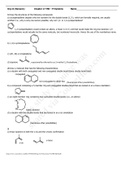
-
Hunter College, CUNY - CHEMISTRY 222Chap 16 Pi Systems F18 HW KEY
- Exam (elaborations) • 9 pages • 2021
-
- $13.49
- + learn more
Org II (Hamann) Chapter 17 HW – Pi Systems Name 1 Draw the structures of the following compounds a) cyclopentadiene (explain why the numbers for the double bonds (1,3-), which are formally require d, are usually omitted. I.e., why is only one isomer possible; why not 1,2- or 1,4-cyclopentadiene? 1,2-cyclopentadiene would contain an allene, a linear C=C=C unit that would make the ring too strained. 1,4- cyclopentadiene would actually be the same molecule, but numbered incorrectly. Hence the use...
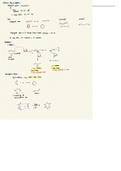
-
Organic Chemistry 2: Conjugated Pi Systems Summary
- Summary • 2 pages • 2022
- Available in package deal
-
- $5.49
- + learn more
This document is a summary of the conjugated pi systems chapter of the organic chemistry 2 course. It is digitally taken, handwritten notes. It covers topics on HOMO and LUMO structures, energy levels as well as molecule stability. Notes also cover information dienes, their nomenclature as well as their properties. Thoroughly explained subtopics include 1,2 and 1,4 addition, pericyclic reactions, Diel’s - Alder reaction as well as sigmatropic, Cope and Cleissen rearrangements. Notes show mecha...
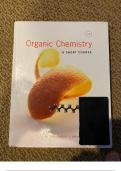
-
Organic Chemistry A Short Course 13Th Ed By Hart - Test Bank
- Exam (elaborations) • 260 pages • 2023
-
- $26.88
- + learn more
Chapter 3 -- Alkenes and Alkynes MULTIPLE CHOICE 1. Which of the following dienes can be classified as conjugated? A) CH3CH=C=CH2 B) CH3CH=CHCH=CH2 C) CH2=CHCH2CH=CH2 D) CH3CH=CHCH2CH2CH=CH2 E) CH2=C=CH2 ANS: B TOP: Alkenes and Alkynes: Nomenclature and Structure 2. Which of the following molecular formulas could not represent an alkene? A) C5H10 B) C7H14 C) C10H20 D) C27H56 E) C31H62 ANS: D TOP: Alkenes and Alkynes: Nomenclature and Structure 3. What...
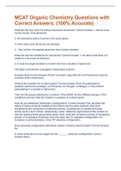
-
MCAT Organic Chemistry Questions with Correct Answers. (100% Accurate)
- Exam (elaborations) • 28 pages • 2023
-
- $9.49
- + learn more
What are the four rules for writing resonance structures? Correct Answer 1. Atoms must not be moved. Only electrons. 2. All resonance atoms must lie in the same plane. 3. Only valid Lewis structures are allowed. 4 . The number of unpaired electrons must remain constant. What are the two conditions for resonance? Correct Answer 1. An atom must have a P orbital or a lone pair of electrons. 2. It must be single bonded to an atom that has a double or triple bond. The latter comprom...
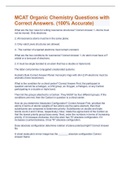
-
MCAT Organic Chemistry Questions with Correct Answers. (100% Accurate)
- Exam (elaborations) • 28 pages • 2023
-
- $9.49
- + learn more
What are the four rules for writing resonance structures? Correct Answer 1. Atoms must not be moved. Only electrons. 2. All resonance atoms must lie in the same plane. 3. Only valid Lewis structures are allowed. 4 . The number of unpaired electrons must remain constant. What are the two conditions for resonance? Correct Answer 1. An atom must have a P orbital or a lone pair of electrons. 2. It must be single bonded to an atom that has a double or triple bond. The latter comprom...
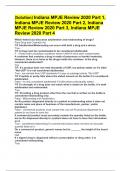
-
(Solution) Indiana MPJE Review 2020 Part 1, Indiana MPJE Review 2020 Part 2, Indiana MPJE Review 2020 Part 3, Indiana MPJE Review 2020 Part 4
- Exam (elaborations) • 38 pages • 2024
-
- $22.99
- + learn more
(Solution) Indiana MPJE Review 2020 Part 1, Indiana MPJE Review 2020 Part 2, Indiana MPJE Review 2020 Part 3, Indiana MPJE Review 2020 Part 4 Which federal act discusses adulteration and misbranding of drugs? Food Drug and Cosmetic Act T/F Adulteration/Misbranding can occur with both a drug and a device. True T/F A drug must be contaminated to be considered adulterated. F - if held under unsanitary conditions where it MAYA have been contaminated A container that contains a drug is made ...
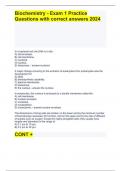
-
Biochemistry - Exam 1 Practice Questions with correct answers 2024
- Exam (elaborations) • 16 pages • 2024
-
Available in package deal
-
- $7.99
- + learn more
In a bacterial cell, the DNA is in the: A) cell envelope. B) cell membrane. C) nucleoid. D) nucleus. E) ribosomes. - answer-nucleoid A major change occurring in the evolution of eukaryotes from prokaryotes was the development of: A) DNA. B) photosynthetic capability. C) plasma membranes. D) ribosomes. E) the nucleus - answer-the nucleus In eukaryotes, the nucleus is enclosed by a double membrane called the: A) cell membrane. B) nuclear envelope. C) nucleolus. D) n...
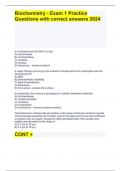
-
Biochemistry - Exam 1 Practice Questions with correct answers 2024
- Exam (elaborations) • 16 pages • 2024
-
Available in package deal
-
- $7.99
- + learn more
In a bacterial cell, the DNA is in the: A) cell envelope. B) cell membrane. C) nucleoid. D) nucleus. E) ribosomes. - answer-nucleoid A major change occurring in the evolution of eukaryotes from prokaryotes was the development of: A) DNA. B) photosynthetic capability. C) plasma membranes. D) ribosomes. E) the nucleus - answer-the nucleus In eukaryotes, the nucleus is enclosed by a double membrane called the: A) cell membrane. B) nuclear envelope. C) nucleolus. D) n...
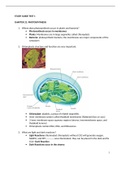
-
BIOL 3362 - EXAM 1 STUDY GUIDE (Biochemistry, Photosynthesis, Amino Acids).
- Other • 32 pages • 2021
- Available in package deal
-
- $10.99
- + learn more

$6.50 for your textbook summary multiplied by 100 fellow students... Do the math: that's a lot of money! Don't be a thief of your own wallet and start uploading yours now. Discover all about earning on Stuvia


